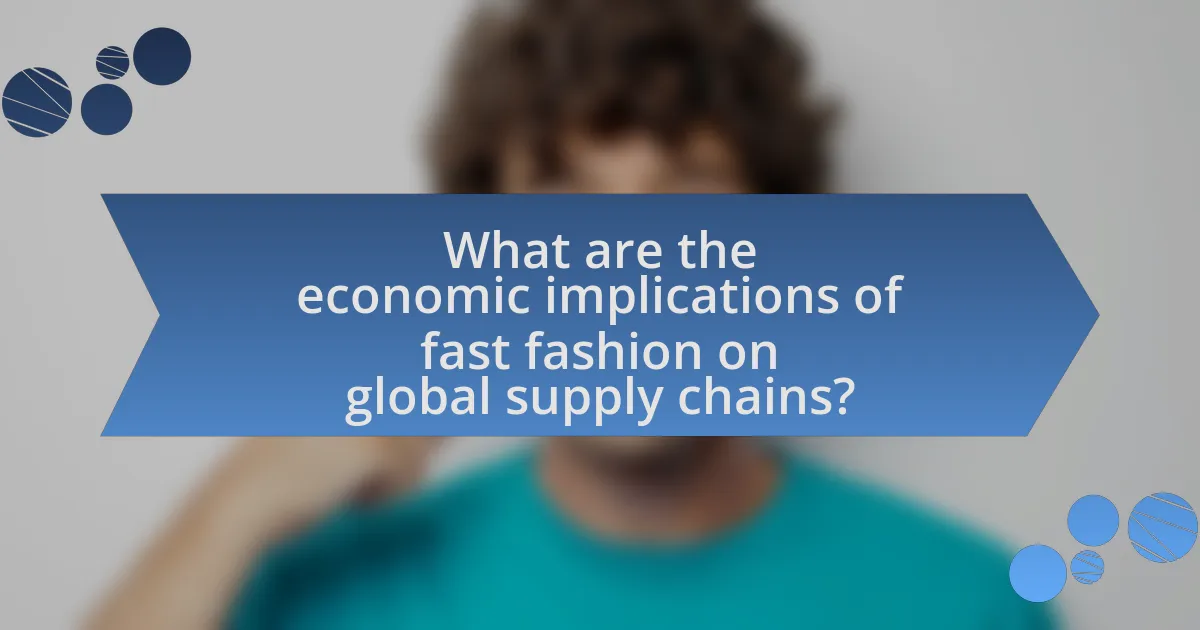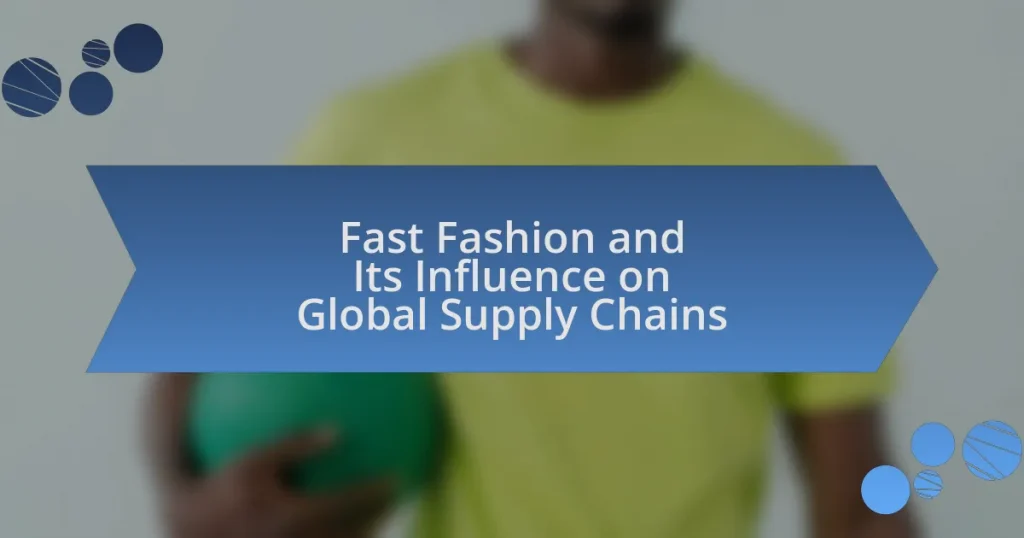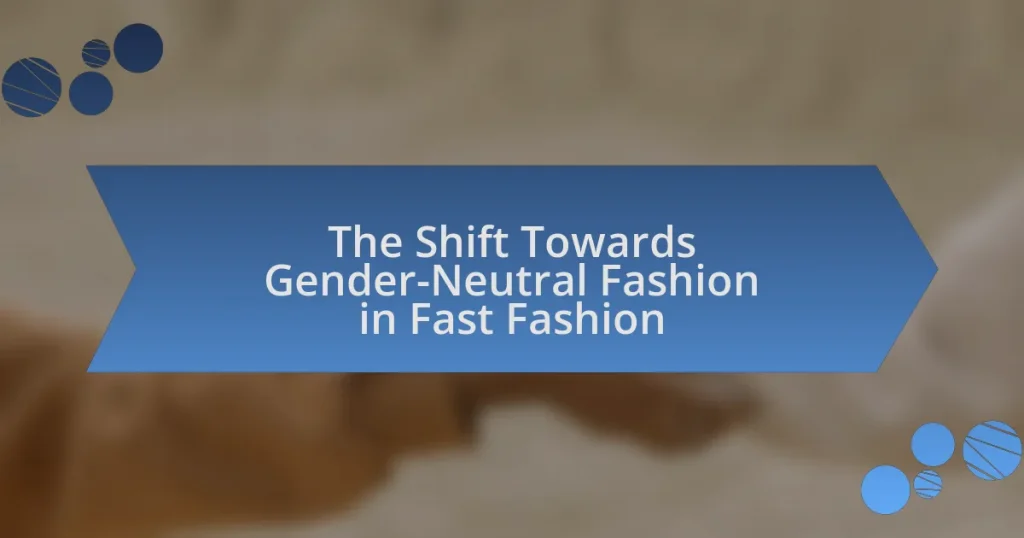Fast fashion is characterized by the rapid production of inexpensive clothing that mirrors current trends, significantly impacting global supply chains by prioritizing speed and cost-efficiency. This model has emerged due to globalization, technological advancements, and changing consumer behavior, leading to increased pressure on suppliers and often resulting in poor labor conditions and environmental degradation. The article explores the historical context of fast fashion, its economic implications, the role of technology, and the environmental and labor issues it raises, while also discussing emerging alternatives and best practices for sustainability in the fashion industry.

What is Fast Fashion and Its Influence on Global Supply Chains?
Fast fashion refers to the rapid production of inexpensive clothing that mimics current fashion trends, allowing retailers to quickly respond to consumer demand. This business model significantly influences global supply chains by prioritizing speed and cost-efficiency, often leading to the outsourcing of production to countries with lower labor costs. For instance, brands like Zara and H&M can design, produce, and distribute new collections in a matter of weeks, which requires a highly coordinated supply chain that includes sourcing materials, manufacturing, and logistics. The reliance on fast fashion has resulted in increased pressure on suppliers to meet tight deadlines, often at the expense of labor rights and environmental standards, as evidenced by reports indicating that garment workers frequently face poor working conditions and low wages.
How did the concept of fast fashion emerge?
The concept of fast fashion emerged in the late 20th century as a response to the increasing demand for affordable, trendy clothing. Retailers like Zara and H&M pioneered this model by rapidly producing inexpensive garments that mirrored high-fashion trends, allowing consumers to purchase new styles frequently. This shift was facilitated by advancements in manufacturing and supply chain logistics, enabling brands to reduce production times from months to weeks. The rise of globalization also played a crucial role, as brands outsourced production to countries with lower labor costs, further driving down prices and increasing the availability of fashionable clothing.
What historical events contributed to the rise of fast fashion?
The rise of fast fashion was significantly influenced by the globalization of trade in the late 20th century, particularly after the 1994 North American Free Trade Agreement (NAFTA) and the establishment of the World Trade Organization (WTO) in 1995. These events facilitated the reduction of tariffs and trade barriers, allowing clothing manufacturers to source materials and labor from countries with lower production costs. Additionally, advancements in technology, such as the internet and supply chain management systems, enabled brands to quickly respond to fashion trends and consumer demands. The combination of these factors led to the rapid production cycles and low-cost offerings characteristic of fast fashion, reshaping global supply chains in the apparel industry.
How has consumer behavior influenced the fast fashion industry?
Consumer behavior has significantly influenced the fast fashion industry by driving demand for rapid production and low-cost clothing. This demand is fueled by consumers’ desire for trendy, affordable apparel, leading brands to adopt a model that prioritizes quick turnaround times and frequent inventory changes. For instance, studies show that fast fashion retailers like Zara and H&M can design, produce, and distribute new collections in as little as two weeks, responding directly to consumer trends and preferences. This responsiveness to consumer behavior has reshaped supply chains, emphasizing speed and efficiency to meet the ever-changing demands of shoppers.
What are the key characteristics of fast fashion?
The key characteristics of fast fashion include rapid production cycles, low-cost garments, and a focus on current trends. Fast fashion brands quickly design, manufacture, and distribute clothing to meet the latest fashion trends, often within weeks. This model relies on inexpensive materials and labor, allowing for affordable pricing that attracts consumers. Additionally, fast fashion promotes a culture of disposability, encouraging frequent purchases and rapid turnover of inventory. According to a 2019 report by the Ellen MacArthur Foundation, the fast fashion industry contributes significantly to environmental degradation, with an estimated 92 million tons of textile waste generated annually.
How does fast fashion differ from traditional fashion retail?
Fast fashion differs from traditional fashion retail primarily in its speed and production model. Fast fashion brands rapidly produce inexpensive clothing in response to the latest trends, often releasing new collections weekly, while traditional fashion retail typically follows a seasonal model with longer production cycles. For instance, fast fashion companies like Zara can design, manufacture, and distribute new items in as little as two weeks, compared to traditional retailers that may take several months to bring a collection to market. This rapid turnaround allows fast fashion to capitalize on current trends quickly, leading to higher inventory turnover and lower prices, which contrasts with the more deliberate and often higher-priced offerings of traditional fashion retailers.
What role does speed play in the fast fashion supply chain?
Speed is crucial in the fast fashion supply chain as it enables brands to quickly respond to changing consumer trends and demands. The ability to design, produce, and distribute clothing within weeks, rather than months, allows companies to capitalize on current fashion trends and maintain a competitive edge. For instance, brands like Zara can take a design from concept to store shelves in as little as two weeks, significantly faster than traditional retailers, which may take six months or longer. This rapid turnaround not only meets consumer expectations for new styles but also reduces the risk of overproduction and unsold inventory, thereby optimizing profitability.
What are the environmental impacts of fast fashion on global supply chains?
Fast fashion significantly contributes to environmental degradation within global supply chains. The production processes often involve high water consumption, with the industry using approximately 93 billion cubic meters of water annually, leading to water scarcity in many regions. Additionally, fast fashion generates substantial textile waste, with an estimated 92 million tons discarded each year, exacerbating landfill issues and pollution. The reliance on synthetic fibers, such as polyester, results in microplastic pollution, with millions of microfibers entering oceans and waterways during washing. Furthermore, the carbon footprint of fast fashion is considerable, accounting for about 10% of global carbon emissions, primarily due to energy-intensive manufacturing and transportation practices. These factors collectively illustrate the detrimental environmental impacts of fast fashion on global supply chains.
How does fast fashion contribute to waste and pollution?
Fast fashion contributes to waste and pollution by promoting rapid production cycles and encouraging disposable consumer behavior. The industry produces approximately 92 million tons of textile waste annually, with a significant portion ending up in landfills. Additionally, the manufacturing processes often involve toxic chemicals and dyes, which can contaminate water sources. For instance, the World Bank estimates that the fashion industry is responsible for 20% of global wastewater. This combination of excessive waste generation and environmental degradation highlights the detrimental impact of fast fashion on ecosystems and public health.
What are the implications for sustainable practices in the supply chain?
Sustainable practices in the supply chain lead to reduced environmental impact and improved social responsibility. Implementing these practices can decrease resource consumption, minimize waste, and enhance labor conditions. For instance, a study by the Ellen MacArthur Foundation highlights that transitioning to a circular economy in fashion could generate $560 billion in economic benefits while significantly reducing carbon emissions. Additionally, companies adopting sustainable sourcing and production methods often experience increased consumer loyalty and brand reputation, as evidenced by a Nielsen report indicating that 66% of global consumers are willing to pay more for sustainable brands.
How does fast fashion affect labor practices in global supply chains?
Fast fashion negatively impacts labor practices in global supply chains by promoting exploitative working conditions and low wages. Brands prioritize rapid production and low costs, often leading to the outsourcing of manufacturing to countries with lax labor regulations. For instance, a report by the International Labour Organization highlights that workers in fast fashion supply chains frequently endure long hours, unsafe environments, and inadequate pay, with some earning as little as $3 per day. This systemic pressure for quick turnaround and low prices undermines workers’ rights and perpetuates a cycle of poverty and exploitation in the garment industry.
What are the working conditions in factories producing fast fashion?
Working conditions in factories producing fast fashion are often characterized by low wages, long hours, and unsafe environments. Workers typically earn below the minimum wage, with reports indicating that many receive as little as $3 per day, which is insufficient to meet basic living standards. Additionally, employees frequently work excessive hours, sometimes exceeding 60 hours a week, without adequate breaks or overtime compensation. Safety standards are often neglected, leading to hazardous conditions, such as exposure to toxic chemicals and the risk of accidents due to inadequate safety measures. For instance, the 2013 Rana Plaza collapse in Bangladesh, which killed over 1,100 workers, highlighted the dire safety issues prevalent in the fast fashion industry. These conditions reflect a systemic disregard for labor rights and worker welfare in the pursuit of rapid production and low costs.
How do labor laws vary across countries involved in fast fashion?
Labor laws vary significantly across countries involved in fast fashion, with some nations enforcing strict regulations while others have minimal protections for workers. For instance, countries like Bangladesh and Cambodia have labor laws that often lack enforcement, leading to poor working conditions and low wages in garment factories. In contrast, countries such as Germany and Sweden have robust labor laws that include strong worker protections, minimum wage standards, and rights to unionize. According to the International Labour Organization, the disparity in labor law enforcement contributes to the exploitation of workers in developing countries, where fast fashion brands often source their products to minimize costs.

What are the economic implications of fast fashion on global supply chains?
The economic implications of fast fashion on global supply chains include increased production speed, reduced costs, and significant environmental and labor concerns. Fast fashion brands prioritize rapid turnover of styles, leading to a demand for quick manufacturing processes that often rely on low-cost labor in developing countries. This model can drive down prices for consumers but often results in poor working conditions and exploitation of workers, as seen in reports from organizations like the International Labour Organization. Additionally, the fast fashion industry contributes to environmental degradation, with the Ellen MacArthur Foundation estimating that the fashion industry is responsible for 10% of global carbon emissions. Thus, while fast fashion can stimulate economic activity and provide affordable clothing options, it also raises critical ethical and sustainability issues within global supply chains.
How does fast fashion impact local economies?
Fast fashion negatively impacts local economies by undermining traditional textile industries and reducing job opportunities. As global brands prioritize low-cost production in developing countries, local manufacturers struggle to compete, leading to factory closures and job losses. For instance, in countries like Bangladesh, the influx of fast fashion has resulted in a significant decline in local garment production, with a reported 30% decrease in small-scale textile businesses between 2010 and 2020. This shift not only diminishes local employment but also affects the economic stability of communities reliant on these industries.
What are the benefits and drawbacks for manufacturers in developing countries?
Manufacturers in developing countries benefit from lower labor costs and access to emerging markets, which can lead to increased production and profitability. For instance, countries like Bangladesh and Vietnam have significantly lower wage rates compared to developed nations, allowing manufacturers to produce goods at a fraction of the cost, thus attracting global brands seeking to minimize expenses.
However, drawbacks include poor working conditions and limited regulatory oversight, which can lead to exploitation and labor rights violations. Reports from organizations like the International Labour Organization highlight that many workers in these regions face unsafe environments and inadequate wages, undermining their well-being and job security. Additionally, reliance on fast fashion can create economic instability, as demand fluctuations may lead to sudden job losses and factory closures.
How does fast fashion influence pricing strategies in the retail market?
Fast fashion significantly influences pricing strategies in the retail market by promoting lower prices and rapid inventory turnover. Retailers adopt aggressive pricing tactics to remain competitive, often resulting in reduced profit margins. For instance, brands like Zara and H&M frequently release new collections at low prices, encouraging consumers to purchase more frequently. This strategy is supported by a supply chain model that emphasizes speed and efficiency, allowing these retailers to respond quickly to fashion trends while keeping costs low. According to a report by McKinsey & Company, fast fashion brands can produce garments at a fraction of the cost of traditional retailers, which further drives down prices in the market.
What role do technology and innovation play in fast fashion supply chains?
Technology and innovation are critical in fast fashion supply chains as they enhance efficiency, speed, and responsiveness. Advanced technologies such as artificial intelligence, data analytics, and automation streamline processes from design to distribution, allowing brands to quickly adapt to changing consumer trends. For instance, companies like Zara utilize real-time data to inform inventory decisions, reducing lead times to as little as two weeks. Furthermore, innovations in sustainable materials and production techniques are increasingly being integrated to address environmental concerns, reflecting a shift towards more responsible practices within the fast fashion model. This combination of speed and adaptability, driven by technology, enables fast fashion brands to maintain competitiveness in a rapidly evolving market.
How has technology changed the production process in fast fashion?
Technology has significantly transformed the production process in fast fashion by enabling rapid design, manufacturing, and distribution. Advanced software tools allow brands to analyze trends and consumer preferences in real-time, leading to quicker design cycles. Automation in manufacturing, such as the use of robotics and 3D printing, has streamlined production, reducing lead times from months to weeks. Additionally, digital supply chain management systems enhance inventory tracking and logistics, ensuring that products reach consumers faster. According to a report by McKinsey & Company, the integration of technology in fast fashion has led to a 30% reduction in time-to-market, illustrating the profound impact of technological advancements on the industry.
What innovations are shaping the future of fast fashion supply chains?
Innovations shaping the future of fast fashion supply chains include advanced data analytics, automation, and sustainable materials. Advanced data analytics enables brands to predict trends and consumer preferences more accurately, leading to faster production cycles. Automation, through technologies like robotics and AI, streamlines manufacturing processes, reducing lead times and costs. Additionally, the adoption of sustainable materials, such as recycled fabrics and biodegradable textiles, addresses environmental concerns while meeting consumer demand for eco-friendly products. These innovations collectively enhance efficiency, responsiveness, and sustainability in fast fashion supply chains.

What are the future trends in fast fashion and global supply chains?
Future trends in fast fashion and global supply chains include increased sustainability, digital transformation, and localized production. Sustainability is becoming a priority as consumers demand eco-friendly practices, prompting brands to adopt circular economy models and reduce waste. Digital transformation is reshaping supply chains through advanced technologies like AI and blockchain, enhancing transparency and efficiency. Localized production is gaining traction to reduce lead times and transportation emissions, with brands increasingly investing in nearshoring strategies. These trends are supported by market research indicating that 66% of consumers are willing to pay more for sustainable brands, highlighting the shift towards responsible consumption.
How is consumer demand shifting in relation to fast fashion?
Consumer demand is shifting towards sustainability and ethical practices in relation to fast fashion. Increasing awareness of environmental issues and labor conditions has led consumers to prefer brands that prioritize eco-friendly materials and fair labor practices. For instance, a 2021 survey by McKinsey & Company found that 67% of consumers consider the use of sustainable materials important when making fashion purchases. This shift is prompting fast fashion retailers to adapt their business models, incorporating more sustainable practices to meet changing consumer expectations.
What are the emerging alternatives to fast fashion?
Emerging alternatives to fast fashion include sustainable fashion brands, second-hand clothing markets, and rental services. Sustainable fashion brands focus on eco-friendly materials and ethical production practices, reducing environmental impact and promoting fair labor conditions. Second-hand clothing markets, such as thrift stores and online resale platforms, extend the lifecycle of garments and minimize waste. Rental services allow consumers to access high-quality clothing for special occasions without the need for ownership, further decreasing demand for new fast fashion items. These alternatives collectively address the environmental and social issues associated with fast fashion, promoting a more responsible approach to clothing consumption.
How are brands adapting to changing consumer preferences?
Brands are adapting to changing consumer preferences by implementing sustainable practices and enhancing digital engagement. For instance, many fast fashion brands are now prioritizing eco-friendly materials and transparent supply chains to meet the growing demand for sustainability among consumers. According to a 2021 McKinsey report, 67% of consumers consider the use of sustainable materials to be important when making purchasing decisions. Additionally, brands are leveraging technology, such as AI and data analytics, to better understand consumer behavior and preferences, allowing for more personalized marketing strategies. This shift not only aligns with consumer values but also helps brands remain competitive in a rapidly evolving market.
What best practices can be adopted to mitigate the negative impacts of fast fashion?
To mitigate the negative impacts of fast fashion, consumers and brands should adopt sustainable practices such as prioritizing quality over quantity, supporting ethical brands, and embracing circular fashion. Prioritizing quality ensures that garments last longer, reducing waste; for instance, clothing made from durable materials can decrease the frequency of purchases. Supporting ethical brands that pay fair wages and maintain safe working conditions can help improve labor practices in the fashion industry. Embracing circular fashion, which includes recycling and upcycling garments, can significantly reduce textile waste; according to the Ellen MacArthur Foundation, transitioning to a circular economy in fashion could reduce global carbon emissions by 44% by 2030. These practices collectively contribute to a more sustainable fashion industry and lessen the environmental and social impacts associated with fast fashion.
How can brands implement sustainable practices in their supply chains?
Brands can implement sustainable practices in their supply chains by adopting eco-friendly materials, optimizing logistics, and ensuring ethical labor practices. For instance, using organic cotton or recycled polyester reduces environmental impact, while efficient logistics can minimize carbon emissions. Additionally, brands can enforce fair labor standards to promote social sustainability. According to a 2021 report by McKinsey & Company, 66% of consumers are willing to pay more for sustainable brands, indicating a market demand for these practices.
What role can consumers play in promoting ethical fashion choices?
Consumers play a crucial role in promoting ethical fashion choices by making informed purchasing decisions that prioritize sustainability and fair labor practices. When consumers choose to buy from brands that adhere to ethical standards, they signal to the market that there is demand for responsible production methods. Research indicates that 66% of global consumers are willing to pay more for sustainable brands, demonstrating a significant shift towards ethical consumption. By supporting companies that are transparent about their supply chains and practices, consumers can drive change in the fashion industry, encouraging more brands to adopt ethical practices to meet consumer expectations.















